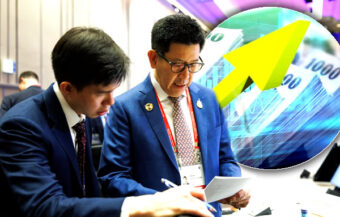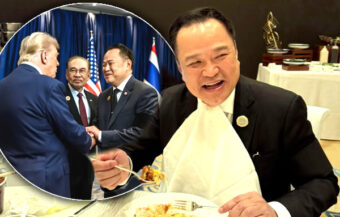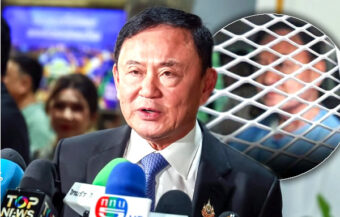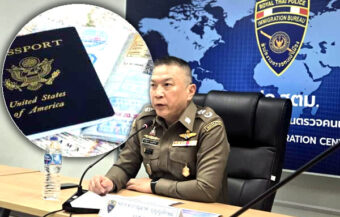Thailand shifts focus to wealthy European tourists after Chinese arrivals collapse. Officials push long-stay travel and high-end spending, but confusion over visas, safety concerns, and past missteps raise fears a surging recovery in this market could stall again.
This week, Thailand reported a 1% drop in foreign tourist arrivals year on year up to May 11th. It also marked the return of former Tourism Authority of Thailand (TAT) governor Yuthasak Supasorn to the spotlight, as he voiced concern over falling numbers from China and other Asian markets. However, the decline came alongside a 19% surge in high-spending European arrivals during the same period. The shift follows a recent move by Natthriya Thaweevong, Permanent Secretary at the Ministry of Tourism and Sports, who approved a new focus on attracting wealthier tourists from Europe and the Middle East. Still, many in the tourism industry are growing uneasy. There’s rising concern the government may overreact by shortening visa stays, further fuelling uncertainty. At the same time, others back the pivot away from short-haul Asian markets, with some even identifying this strategy as a key to addressing Thailand’s long-standing tourism challenges.

Thailand is turning its gaze westward after a sluggish start to 2025 exposed deep cracks in its recent tourism model. Official data shows 12.9 million international arrivals in the first four months and 11 days — down 1.04% from last year. Even as the global travel industry recovers, Thailand is lagging behind.
The biggest shock came from East Asia. Arrivals from China, once the kingdom’s golden goose, were dismal. Only 1.77 million Chinese visitors arrived between January and May 11. That’s just 16% of the 2019 peak. Daily arrivals are presently stuck at around 3,000. Before Covid, it was closer to 30,000.
The sharp drop in turn reignited scrutiny from former Tourism Authority of Thailand (TAT) Governor Yuthasak Supasorn.
Thailand’s former reliance on Chinese tourists has backfired as East Asian arrivals continue to collapse
During his eight-year tenure, Mr Yuthasak made China the backbone of Thailand’s inbound strategy. In 2019, Chinese travellers made up more than a quarter of all arrivals. Over 11 million came that year.
But the risks of that single-market focus are now painfully clear.
China’s outbound travel remains slow, despite visa waivers. Political tensions, safety fears, and online disinformation have dragged confidence down. A Chinese actor was kidnapped in Thailand in March and transported to Myanmar. His story — widely shared — sparked fresh concerns about travel safety in the kingdom.
Since 2023, Chinese social media platforms have allowed viral falsehoods about Thai crime, trafficking, and terrorism to circulate unchecked. Although Thai officials have tried to counter the narrative, the damage has been done. Efforts to assure travellers have gained little traction.
Meanwhile, the picture across Northeast Asia is equally grim. Hong Kong is down 20.8%. South Korea fell 14.9%. Malaysia, Thailand’s top market so far in 2025, has also lost momentum. The entire ASEAN bloc is down 2.2%. Only Myanmar posted an uptick — up 13.5% — likely driven by border factors.
Thailand’s tourism leaders are no longer betting on a quick Asian rebound.
Thai tourism officials are pivoting to Europe as Asian markets stagnate and arrivals show no sign of recovery
TAT Governor Thapanee Kiatphaibool has set her sights on Europe. And the early results look promising. Between January and April, 3.5 million European visitors arrived — up 18.91% year-on-year. That momentum is accelerating into summer.
In fact, forward bookings for July to September are already up 21%. October to December is also strong, with a projected 17% rise. This contrasts sharply with Asia, where flight capacities remain tight and consumer confidence is still fragile.
Crucially, European markets are not just growing — they’re diversifying. While Russia, the UK, France and Germany remain top performers, smaller nations are surging. Arrivals from Israel jumped 91.07%. Uzbekistan soared 62.57%. Poland rose 38.94%. Romania grew 32.54%.
Moreover, spending is higher. Long-haul travellers stay longer, visit more regions, and spend more per day. Western Europeans tend to book higher-end accommodation and explore beyond Bangkok and Phuket.
Air access is improving too. New and resumed direct flights are opening key European gateways. Thai Airways is back in Rome. ITA Airways now flies Bangkok–Milan. Norse Atlantic links Bangkok to London. Routes from Paris, Madrid, Brussels, Stockholm, and Oslo are also boosting visibility.
Still, questions linger over whether this strategy shift came too late.
Critics challenge whether Thailand’s new tourism direction should have been launched years earlier
Mr Yuthasak, who now chairs the Industrial Estate Authority of Thailand, has remained vocal. He warns that simply chasing headcount won’t work anymore. At a recent forum, he pointed to the decline in MICE travellers — down 15% in volume and 21% in revenue. He said the model needs fixing.
He’s also concerned by Thailand’s sliding global ranking. The kingdom dropped 12 places in the 2024 Travel & Tourism Development Index. Now ranked 47th, Thailand lags behind Singapore, Malaysia, Indonesia and Vietnam. The biggest losses were in sustainability — down 59 spots — and safety, down 16.
Thailand finds itself downgraded by the World Economic Forum’s Tourism index in its latest wide ranging report
Mr Yuthasak has called for a shift to “supply-driven” development. That means building premium products first, then matching them to high-value demand. He advocates for wellness tourism, regenerative travel and immersive local experiences.
But critics say these ideas aren’t new.
“Mr Yuthasak had eight years to implement supply-side reforms,” said a Bangkok-based hotelier. “Instead, we chased volume from China until it collapsed.”
Indeed, Thailand’s reliance on short-haul, low-spending markets proved fragile. When Chinese tour groups vanished, there was no fallback. The Hong Kong and South Korea downturn only makes matters worse.
Ministry doubles down on high-value long-haul markets amid growing pressure to hit revenue targets
Yet the Ministry of Tourism and Sports in April saw a clear path forward.
Permanent Secretary Natthriya Thaweevong has openly shifted from the former Asia-heavy approach. In April, she urged a hard pivot toward long-haul markets. She favours Europe, the Middle East and North America — regions with more predictable demand and higher spending.
“European tourists stay longer and spend more,” the same Bangkok hotelier says. “They are vital to reaching our ฿2 trillion revenue goal.”
As of 11 May, total foreign tourism income had reached ฿613.17 billion. That’s a solid start, it may be too early to panic. But the road to ฿2 trillion won’t be smooth. It depends on keeping big-spending visitors in the pipeline.
Visa policy could make or break that goal. At present, 90-day stays are permitted for many Western visitors. However, a recently announced government review has triggered confusion. Some hotels have reported cancellations, especially from Scandinavia and Eastern Europe.
The ministry has been warned against shortening long-haul stays. Instead, some resort owners want to extend them.
In addition, they are calling for a push to simplify re-entry rules, support for new flights and improved cross-border connectivity with Laos, Cambodia and Malaysia.
New visa rules tighten for some tourists while European arrivals remain key to Thailand’s recovery hopes
Meanwhile, the government is tightening visa rules elsewhere. A crackdown on long-stay abuse has hit Russians, Indians and Chinese nationals hard. Immigration Police are stepping up investigations into grey businesses, overstays and illegal work.
The tourism ministry insists this is about quality control — not xenophobia.
“We’re not targeting nationalities,” said one senior official. “We’re targeting misuse of the system.”
At the same time, tourism insiders want stability. Flip-flopping visa rules have undermined trust. After a strong first quarter, the European market is seen as the one pillar that can anchor Thailand’s hopes for a renewed foreign tourism sector.
But building trust with long-haul travellers takes time — and consistency.
Thailand’s image must also improve. Safety concerns have spread far beyond China. European media frequently report on scams, transport fraud and random violence. Despite police crackdowns, stories of corruption and impunity persist.
The message is clear: Thailand can no longer afford to rely on reputation alone.
High-spending tourists now compare options more sharply as Thailand struggles to defend its image abroad
In the post-Covid world, travellers compare destinations more critically. Neighbours like Vietnam and Indonesia have upped their game. Even Japan and South Korea are poaching high-spending tourists once loyal to Thailand.
Still, there is hope. Thailand’s rich culture, cuisine and coastline remain huge draws. If officials can fix infrastructure, enforce rules, and market smarter, the turnaround is within reach.
Yet the clock is ticking.
“The numbers don’t lie,” said a senior TAT source. “Europe is the future. Asia is a gamble.”
Tourism chief targets European tourists in the second half of 2025 while cabinet orders shorter visas for holidaymakers
PM on a mission to China to ask President Xi Jinping to help rein in heavy online criticism of the kingdom
White Lotus effect on Thai tourism may make it an elitist destination and turn off mass market punters
For now, the government is banking on a high-season surge. If European visitors return in force — and stay longer — a recovery could emerge. But this time, it must rest on a stronger foundation.
As an Asia-focused policy fades, a new chapter may be written. One driven not by slogans or mass numbers, but by value, trust, and long-term vision. Whether Thailand can finally learn from past mistakes remains of course to be seen.
Join the Thai News forum, follow Thai Examiner on Facebook here
Receive all our stories as they come out on Telegram here
Follow Thai Examiner here
Further reading:
Thaksin does not rule out joining talks in US as Thai team finalises plans. They fly out on Thursday
Trump’s remaking of World trade, if it works, will force Thailand to decide between the US and China
US offers a 90-day tariff pause but Thailand must move faster as it already faces shaved GDP in 2025
PM addresses the nation in shock over last week’s earthquake and this week’s Trump tariff bombshell
Finance Minister to travel to US to import more US food and motorbikes while lowering Thai tariffs


















